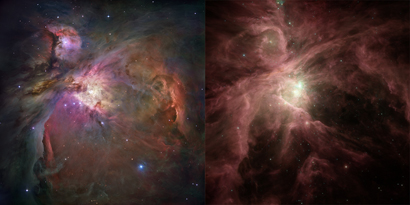Celestron SkyScout for IYA2009: ESA's contribution
 |
For this enhanced SkyScout ESA has provided descriptions of deep-sky objects visible to the naked eye that have also been viewed by space-borne observatories. The user will discover how knowledge about these distant objects is pieced together with the help of telescopes in space and will discover that there is really more than meets the eye.
The Hercules Globular Cluster – a hidden exotic heart
For instance M13, the Hercules Globular Cluster, is barely visible to the naked eye appearing on a very dark, clear night as a smudge of light in the sky. It is a group of several hundred thousand stars packed together into a ball about 145 light years across. The stars of M13 are billions of years old and the European Space Agency’s XMM-Newton, an orbiting observatory that detects powerful X-rays from celestial objects, has discovered a neutron star right at the very heart of this globular cluster.
After running out of nuclear fuel a massive star ends its life dramatically by blowing off its outer layers in a supernova explosion. The core of the original star remains but collapses under gravity to the extent that the protons and electrons combine to form neutrons - hence the name neutron star. Using XMM-Newton astronomers discovered that the neutron star at the centre of M13 is so compressed that despite having a mass nearly twice that of our Sun, it is less than 16 km in diameter. A ball point pen on its surface would weigh billions of tonnes.
The Orion Nebula – a prolific source of water
 |
|
The Orion Nebula imaged by Hubble (left) and Spitzer (right). Credits: Hubble image: NASA, ESA, M. Robberto (Space Telescope Science Institute/ESA) and the Hubble Space Telescope Orion Treasury Project Team; Spitzer image: NASA/JPL-Caltech/T. Megeath (University of Toledo) |
Another example is the Great Orion Nebula, or M42, an exquisite sight in visible light that is unveiled when viewed in the infrared. M42 is full of gas and dust and is the brightest star-forming and diffuse nebula in the night sky. At 1300 light years from us it is actually one of the brightest deep-sky objects of all in visible light, which becomes even brighter in infrared. ESA’s Infrared Space Observatory (ISO) detected many molecules in this nebula, including water which is forming at such an incredible rate that it would fill all the oceans on Earth sixty times over in just one day.
Other objects included in the ESA guide are:
M15, Globular Cluster
M16, the Eagle Nebula
M17, the Horsehead Nebula or the Swan Nebula
M20, the Trifid Nebula
M22, Globular Cluster
M31, the Andromeda Galaxy
M33, the Triangulum Galaxy
M45, Pleiades Cluster
M81, Spiral Galaxy
M82, the Cigar Galaxy
M101, the Pinwheel Galaxy
